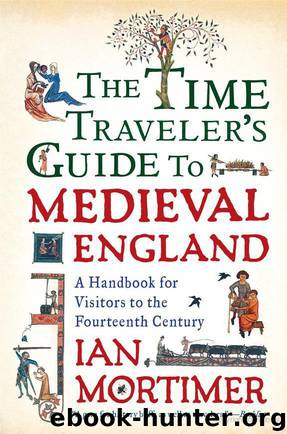The Time Traveler's Guide to Medieval England: A Handbook for Visitors to the Fourteenth Century by Ian Mortimer

Author:Ian Mortimer [Mortimer, Ian]
Language: eng
Format: epub, mobi, azw3
Tags: General, Europe, Great Britain, History, bought-and-paid-for, Medieval, A Handbook for Visitors to the Fourteenth Century
ISBN: 9781439112908
Publisher: Touchstone
Published: 2011-10-25T04:00:00+00:00
Noble Households
When it comes to good food, the nobleman’s table is the place to be. The very best cuisine, and the greatest variety, is served directly to the lord himself at dinner. Long after the grooms and valets have consumed their rations and left the hall, the nobleman will continue eating with his companions, seeing more courses placed before him. The same is the case at supper, even though that is a smaller, less ostentatious meal. At breakfast, the trestle tables will not even be set up for the servants. They have work to do, and there is a belief that too much food makes the worker indolent. Thus the nobleman’s hall represents a spectrum of food quality and quantity, from relatively small amounts of basic pottage at the lower end of the hall to the most expensive dishes and lavish use of color and spices at the top table.
Food and drink in a lord’s residence is based on a series of rules and regulations far more complicated than seasonal availability and economic necessity. In addition to the nonmeat rules set by the Church, late-fourteenth-century aristocratic households are expected to follow legislation restricting the quantities of food. From 1363 even a lord is limited by law to five dishes at any meal: this being part of the aging Edward Ill’s attempts to control extravagance. By this same legislation, gentlemen are allowed only three dishes and grooms two. Of these two, one may be of meat or fish. Although this law is not always followed to the letter, it nevertheless gives you an idea of the level of protocol to expect. Do you rank as high as a gentleman? If you do, you can expect to be seated alongside the gentlemen of the household and fed accordingly.
Let us suppose you have been assigned a place at the top table, along the bench to the right of the nobleman—a position of high honor. Before actually taking your seat, you will have to wash your hands. One servant, the ewerer, will pour the water; it is caught in a bowl beneath your hands by another servant. There is no soap but a third servant will hand you a towel. Then grace is said by the lord’s chaplain, and the first course is brought in and placed before the lord. He will take a trencher and start to help himself from the dishes laid before him. Once he has had a chance to try them, they are passed around.
The first course normally consists of boiled and baked meats in sauces, perhaps ground meat in a spiced wine sauce, or meat balls in aspic. An example of a daily first course of five dishes served to a lord is brawn with mustard, a meat pottage (containing beef or mutton, wine, herbs, and spices), another meat pottage containing chicken or boiled pork, stewed pheasant or swan, and a meat fritter (normally made with the entrails of animals). “Leche Lombard” is a popular first-course dish, consisting of
Download
The Time Traveler's Guide to Medieval England: A Handbook for Visitors to the Fourteenth Century by Ian Mortimer.mobi
The Time Traveler's Guide to Medieval England: A Handbook for Visitors to the Fourteenth Century by Ian Mortimer.azw3
This site does not store any files on its server. We only index and link to content provided by other sites. Please contact the content providers to delete copyright contents if any and email us, we'll remove relevant links or contents immediately.
| Africa | Americas |
| Arctic & Antarctica | Asia |
| Australia & Oceania | Europe |
| Middle East | Russia |
| United States | World |
| Ancient Civilizations | Military |
| Historical Study & Educational Resources |
Elizabeth by Philippa Jones(1862)
Mary Boleyn by Alison Weir(1465)
Traitors of the Tower by Alison Weir(1359)
A Journal of the Plague Year (Oxford World's Classics) by Daniel Defoe(1228)
Eleanor of Aquitaine by Marion Meade(1085)
Moon Tiger by Penelope Lively(1070)
A Short History of England by Simon Jenkins(1066)
The Real Middle Earth by Brian Bates(1049)
Life of Pi by Yann Martel(1031)
London Under by Peter Ackroyd(1017)
Notes From a Small Island by Bill Bryson(1011)
Queen Isabella by Alison Weir(1005)
American Idol by Richard Rushfield(924)
Her Majesty's Spymaster by Stephen Budiansky(909)
Tudors Versus Stewarts by Linda Porter(906)
Albion by Peter Ackroyd(838)
The Creation of Anne Boleyn by Susan Bordo(814)
Cromwell, Our Chief Of Men by Fraser Antonia(814)
Children Of England: The Heirs of King Henry VIII 1547-1558 by Weir Alison(812)
